Meteorological Influences on Trace Gas Transport along the North Atlantic Coast during ICARTT 2004
Abstract
:1. Introduction
2. Methods, Data, and Campaign Details
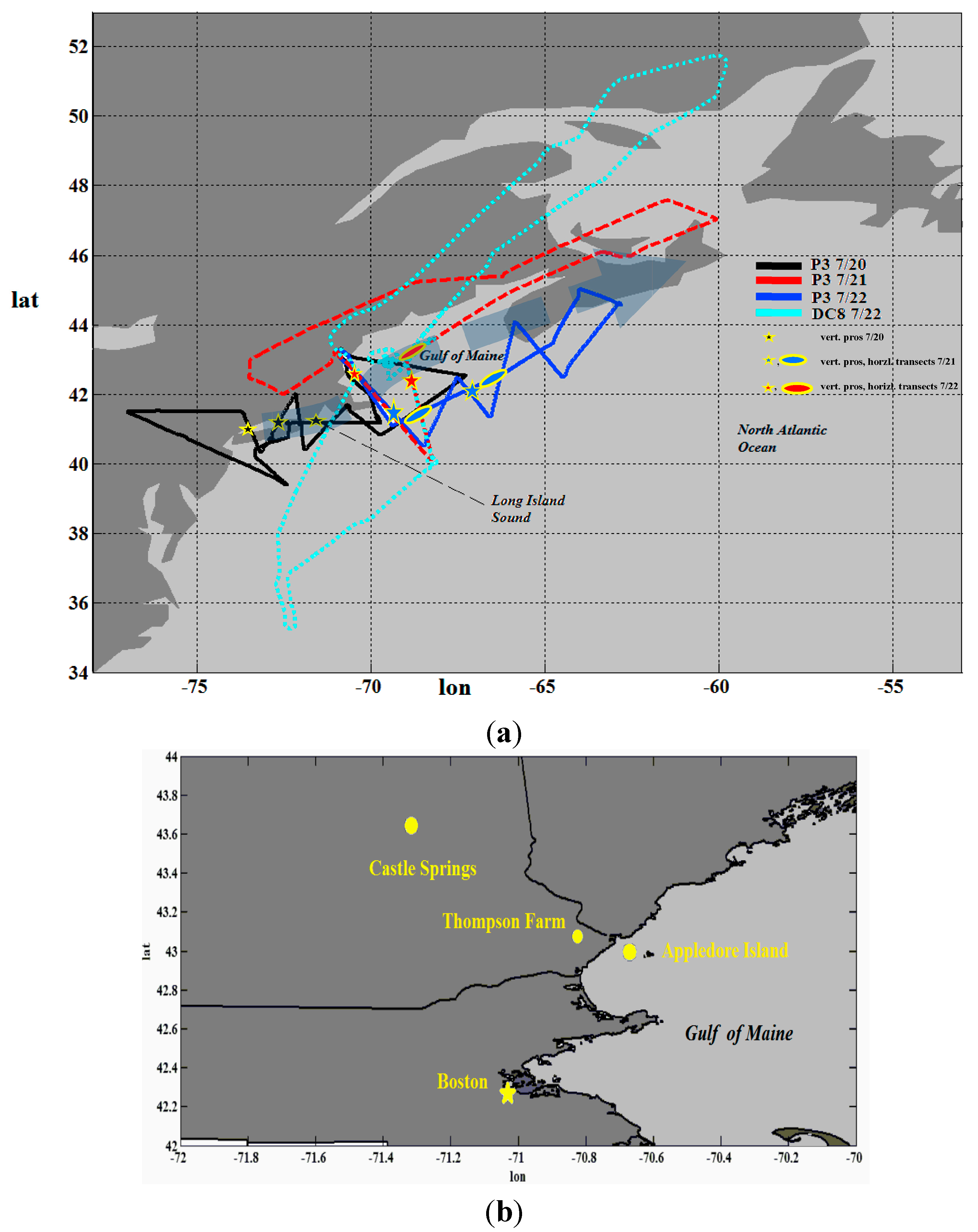
| Sample Species | 720 Correlations | 720 Max | 720 Means | 721 Correlations | 721 Max | 721 Means | 722 Correlations | 722 Max | 722 Means |
|---|---|---|---|---|---|---|---|---|---|
| CH2Cl2 | 0.893 | 264.100 | 82.773 | 0.926 | 63.600 | 43.850 | 0.802 | 23.770 | 21.478 |
| CHCl3 | 0.979 | 28.780 | 17.297 | 0.916 | 22.310 | 16.432 | 0.798 | 22.680 | 20.525 |
| CH3CCL3 | 0.976 | 28.600 | 25.055 | 0.952 | 25.700 | 24.483 | 0.773 | 16.010 | 12.640 |
| CCl4 | 0.550 | 98.000 | 96.091 | 0.167 | 98.000 | 96.333 | 0.162 | 4.900 | 4.398 |
| C2Cl4 | 0.950 | 188.000 | 49.360 | 0.962 | 40.200 | 18.047 | 0.762 | 25.000 | 24.100 |
| C2HCl3 | 0.859 | 28.000 | 8.945 | 0.953 | 5.800 | 3.022 | 0.697 | 96.000 | 95.667 |
| Halon_1211 | 0.953 | 6.020 | 4.744 | 0.907 | 4.850 | 4.510 | 0.704 | 1.400 | 0.853 |
| DMS | 0.410 | 15.510 | 803.595 | 0.434 | 0.390 | 0.240 | 0.478 | 0.960 | 0.480 |
| MeONO2 | 0.995 | 5.470 | 3.526 | 0.434 | 0.390 | 0.240 | 0.478 | 0.960 | 0.480 |
| EthONO2 | 0.919 | 6.560 | 4.276 | 0.868 | 7.480 | 5.205 | 0.715 | 1.310 | 0.635 |
| ETHANE | 0.960 | 2840.000 | 1693.273 | 0.501 | 2423.000 | 1591.200 | 0.587 | 2.240 | 1.533 |
| ETHYNE | 0.986 | 1062.400 | 472.036 | 0.954 | 493.900 | 313.680 | 0.824 | 2.350 | 1.568 |
| PROPANE_MSD | 0.956 | 1694.000 | 721.000 | 0.892 | 1029.000 | 620.670 | 0.774 | 383.000 | 272.830 |
| I_BUTANE | 0.969 | 519.500 | 162.218 | 0.851 | 193.100 | 96.700 | 0.455 | 13.000 | 7.167 |
| N_BUTANE | 0.974 | 670.500 | 225.755 | 0.964 | 255.100 | 122.180 | 0.781 | 374.000 | 269.170 |
| I_PENTANE | 0.985 | 811.200 | 279.909 | 0.966 | 182.100 | 88.850 | 0.830 | 43.200 | 24.550 |
| N_PENTANE | 0.980 | 338.300 | 111.945 | 0.965 | 87.000 | 43.150 | 0.827 | 48.300 | 33.900 |
| ISOPRENE | 0.173 | 800.800 | 218.555 | 0.915 | 0.800 | 0.467 | 0.185 | 37.700 | 18.117 |
| BENZENE | 0.980 | 268.200 | 108.745 | 0.905 | 111.000 | 69.617 | 0.823 | 17.200 | 9.517 |
| TOLUENE | 0.964 | 797.800 | 230.209 | 0.781 | 120.400 | 43.600 | 0.756 | 1.700 | 0.583 |
| Ethyl_benzene | 0.962 | 115.620 | 31.395 | 0.765 | 16.280 | 5.725 | 0.733 | 54.300 | 41.700 |
| DICHLOROETHANE | 0.859 | 5.37 | 4.762 | 0.731 | 4.44 | 4.263 | 0.354 | 3.97 | 3.05 |
| CH4 | 0.961 | 1950.000 | 1856.818 | 0.807 | 1904.000 | 1858.500 | 0.460 | 287.000 | 200.500 |
3. Results and Discussion
3.1. Development of the Plume
3.2. Day 1: Initial Characterization of the Low-Level Plume
3.2.1. Chemical Composition near Long Island Sound
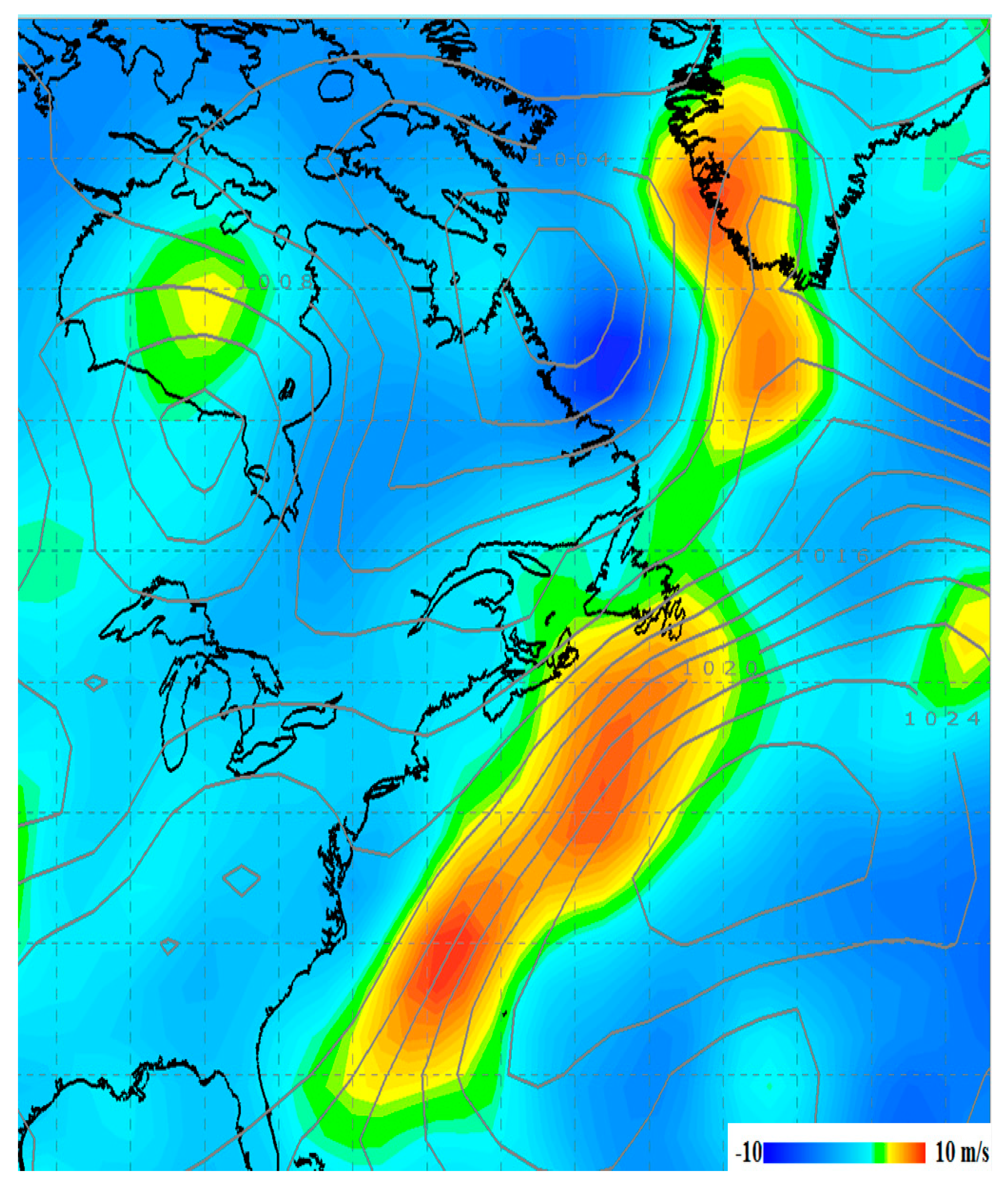

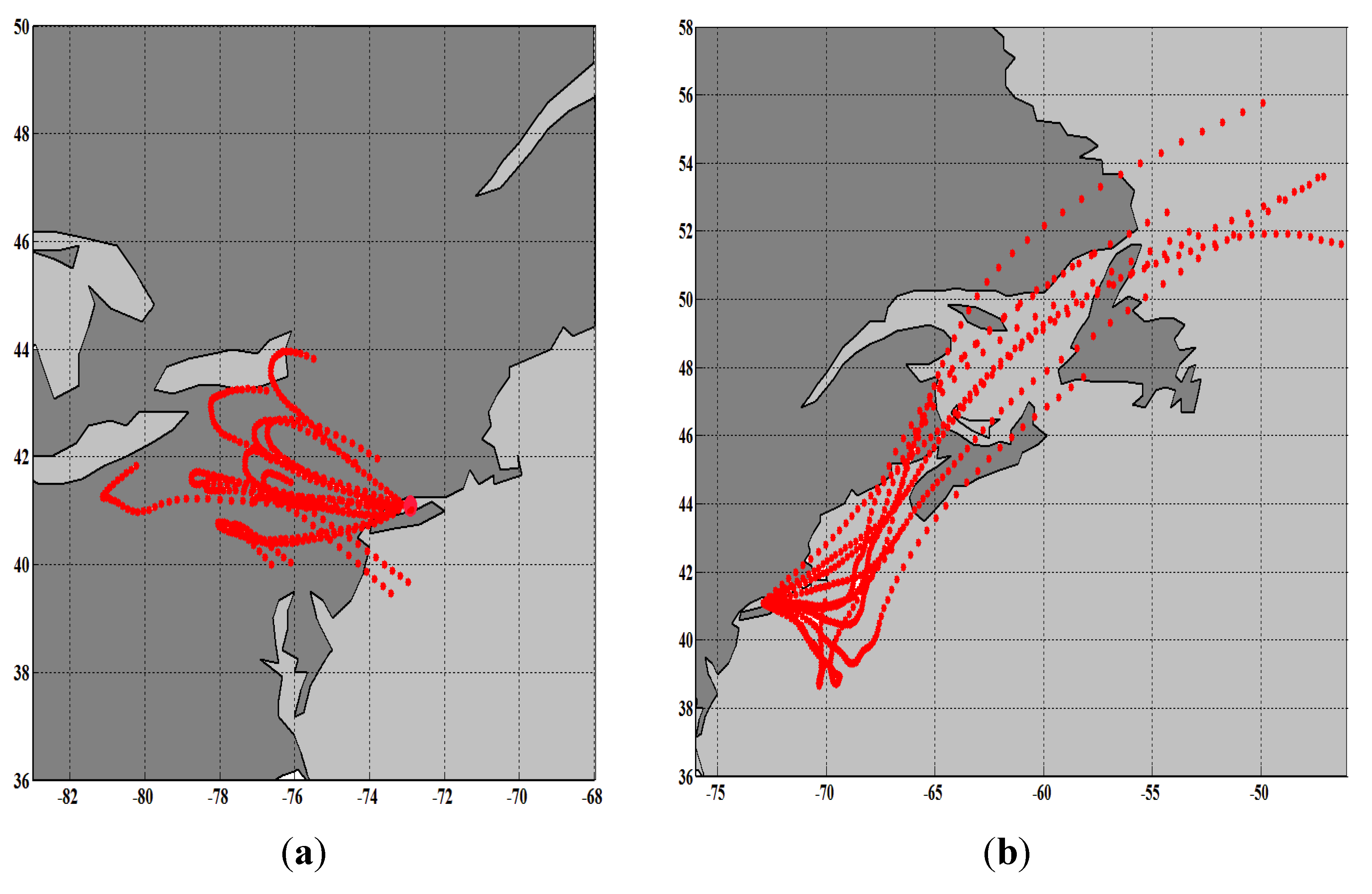
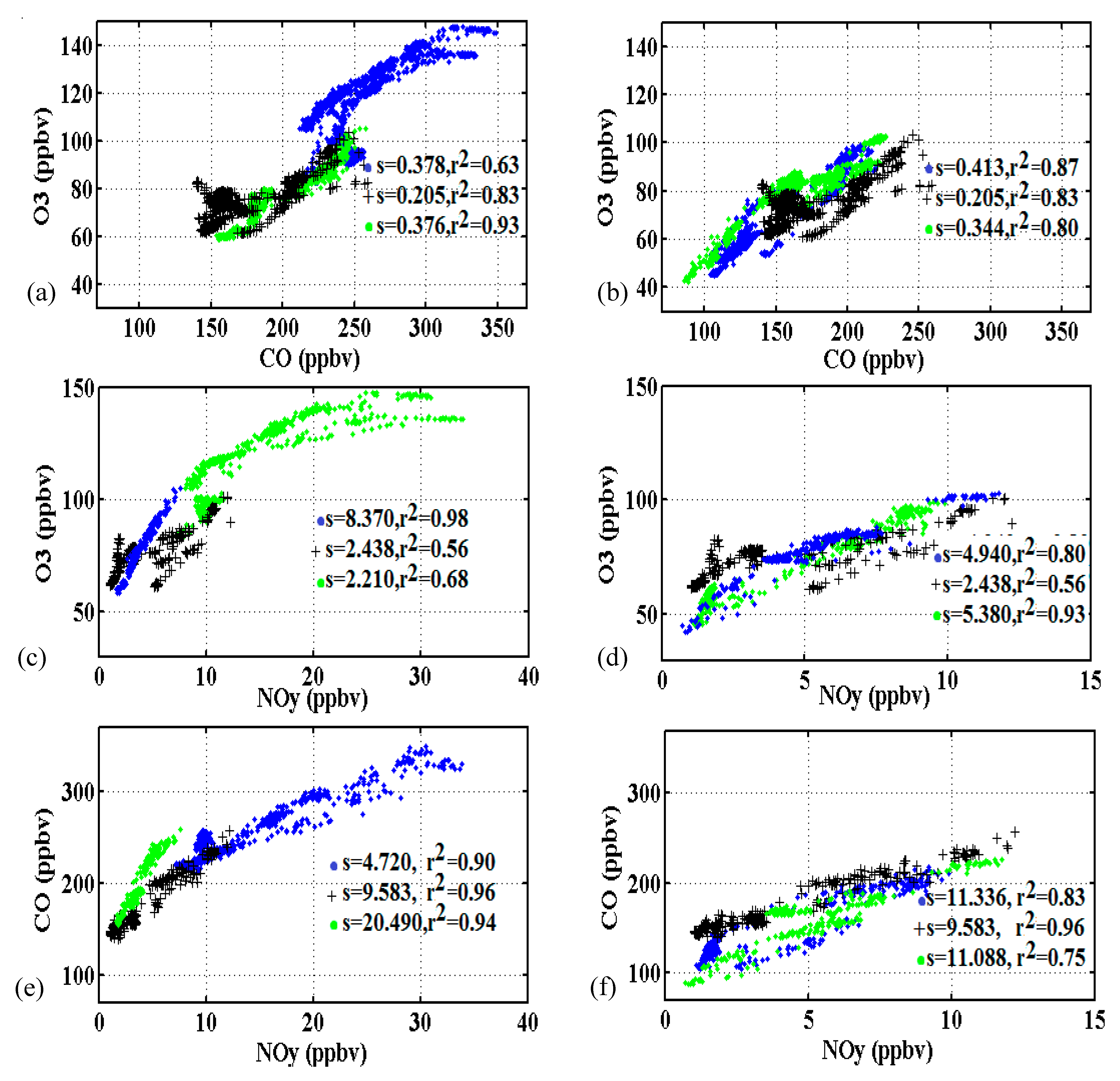
3.2.2. Physical Structure of the Plume Layer
3.3. Low-Level Plume Transit and Evolution on 7/21 and 7/22
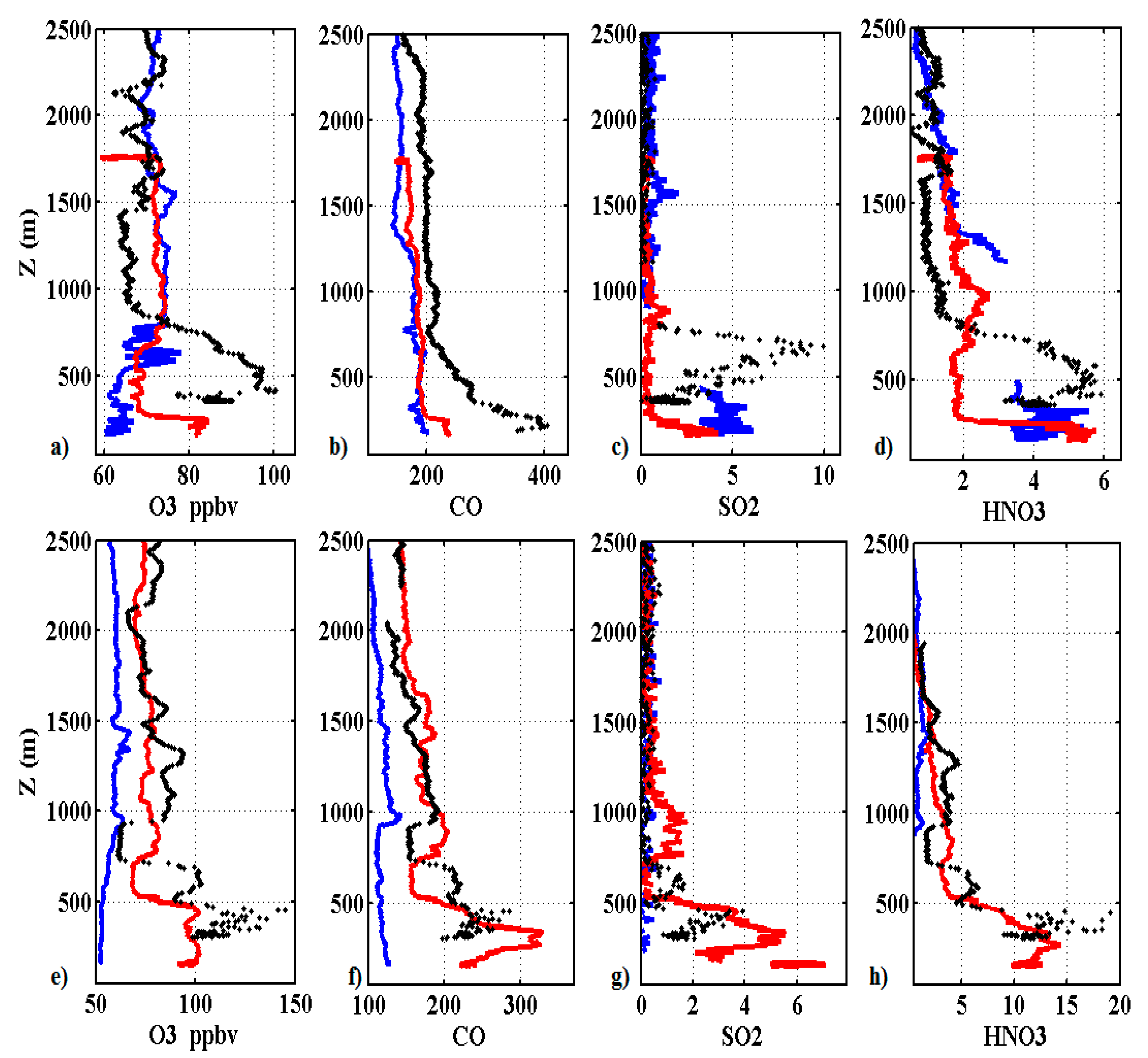
3.3.1. 7/21~Day 2
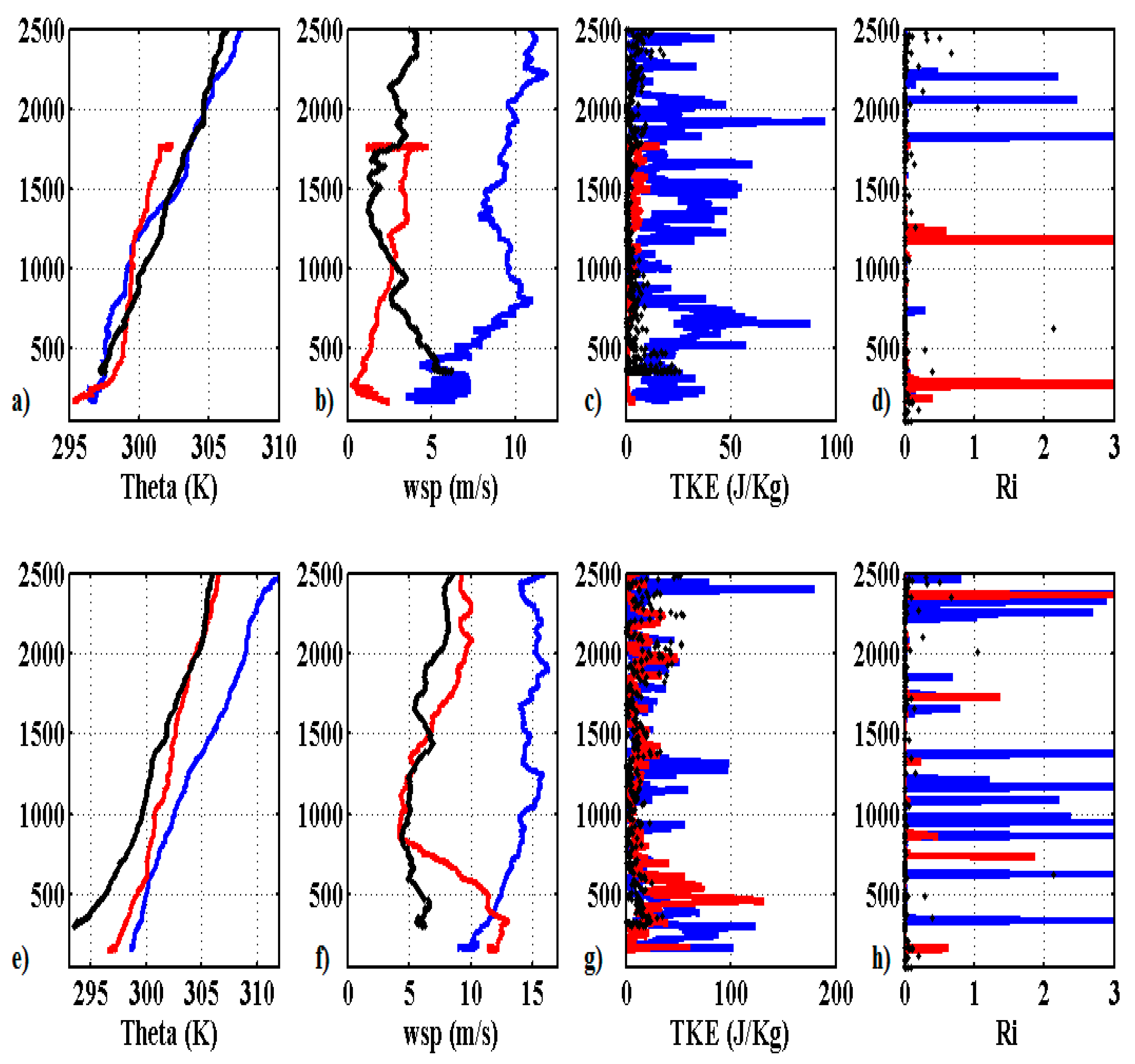
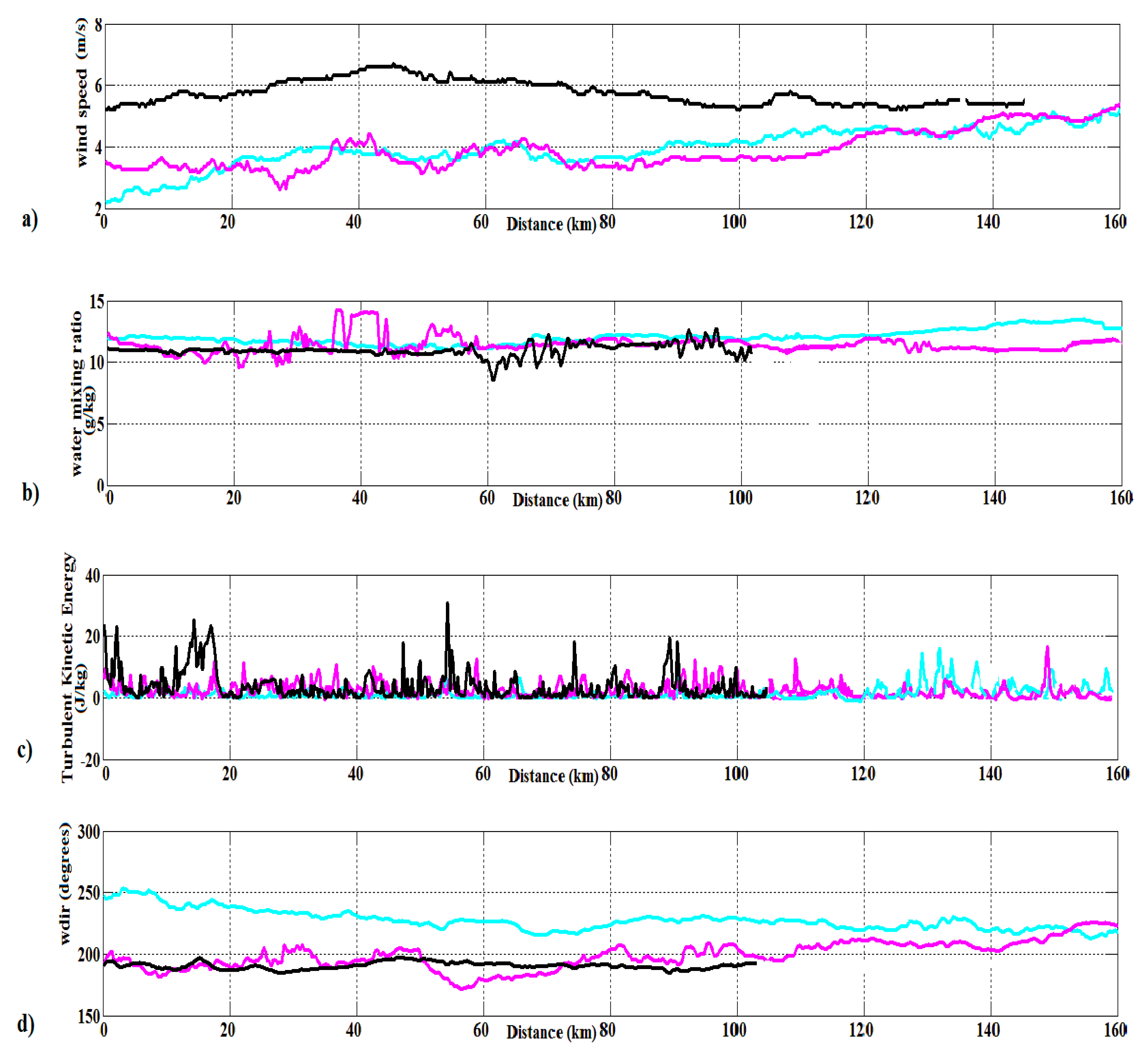

3.3.2. 7/22~Day 3


3.4. Inland Impacts of NYC Plumes

4. Summary and Conclusions
Acknowledgments
Author contributions
Conflict of Interest
References
- Mao, H.; Talbot, R. Relationship of surface O3 to large-scale circulation patterns during two recent winters. Geophys. Res. Lett. 2004. [Google Scholar] [CrossRef]
- Millet, D.B.; Goldstein, A.H.; Holzinger, R.; Williams, B.J.; Allan, J.D.; Jimenez, J.L.; Worsnop, D.R.; Roberts, J.M.; White, A.B.; Hudman, R.C.; et al. Chemical characteristics of North American surface layer outflow: Insights from Chebogue Point Nova Scotia. J. Geophys. Res.: Atmos. 2006. [Google Scholar] [CrossRef]
- Angevine, W.M.; Hare, J.E.; Fairall, C.W.; Wolfe, D.E.; Hill, R.J.; Brewer, W.A.; White, A.B. Structure and formation of the highly stable marine boundary layer over the Gulf of Maine. J. Geophys. Res.: Atmos. 2006. [Google Scholar] [CrossRef]
- Mao, H.; Talbot, R.; Troop, D.; Johnson, R.; Businger, S.; Thompson, A.M. Smart balloon observations over the North Atlantic: O3 data analysis and modeling. J. Geophys. Res.: Atmos. 2006. [Google Scholar] [CrossRef]
- Chen, M.; Talbot, R.; Mao, H.; Sive, B.; Chen, J.; Griffin, R.J. Air mass classification in coastal New England and its relationship to meteorological conditions. J. Geophys. Res.: Atmos. 2007. [Google Scholar] [CrossRef]
- Stohl, A.; Trickl, T. A textbook example of long-range transport: Simultaneous observation of ozone maxima of stratospheric and North American origin in the free troposphere over Europe. J. Geophys. Res.: Atmos. 1999, 104, 30445–30462. [Google Scholar] [CrossRef]
- Stohl, A. A one-year Lagrangian “climatology” of air streams in the northern hemisphere troposphere and lowermost stratosphere. J. Geophys. Res.: Atmos. 2001, 106, 7263–7279. [Google Scholar] [CrossRef]
- Eckhardt, S.; Stohl, A.; Beirle, S.; Spichtinger, N.; James, P.; Forster, C.; Junker, C.; Wagner, T.; Platt, U.; Jennings, S.G.; et al. The North Atlantic Oscillation controls air pollution transport to the Arctic. Atmos. Chem. Phys. 2003, 3, 1769–1778. [Google Scholar] [CrossRef]
- Simmonds, P.G.; Derwent, R.G.; Manning, A.L.; Spain, G. Significant growth in surface ozone at Mace Head, Ireland, 1987–2003. Atmos. Environ. 2003, 38, 4769–4778. [Google Scholar] [CrossRef]
- Daum, P.H.; Kleinman, L.I.; Newman, L.; Luke, W.T.; Weinstein-Lloyd, J.; Berkowitz, C.M.; Busness, K.M. Chemical and physical properties of plumes of anthropogenic pollutants transported over the North Atlantic during the North Atlantic Regional Experiment. J. Geophys. Res.: Atmos. 1996, 101, 29029–29042. [Google Scholar] [CrossRef]
- Owen, R.C.; Cooper, O.R.; Stohl, A.; Honrath, R.E. An analysis of the mechanisms of North American pollutant transport to the central North Atlantic lower free troposphere. J. Geophys. Res.: Atmos. 2006. [Google Scholar] [CrossRef]
- Cooper, O.R.; Moody, J.L.; Parrish, D.D.; Trainer, M.; Ryerson, T.B.; Holloway, J.S.; Hubler, G.; Fehsenfeld, F.C.; Evans, M.J. Trace gas composition of midlatitude cyclones over the western North Atlantic Ocean: A conceptual model. J. Geophys. Res.: Atmos. 2002. [Google Scholar] [CrossRef]
- Angevine, W.M.; Buhr, M.P.; Holloway, J.S.; Trainer, M.; Parrish, D.; MacPherson, J.I.; Kok, G.L.; Dchillawski, R.D.; Bowlby, D.H. Local meteorological features affecting chemical measurements at a North Atlantic coastal site. J. Geophys. Res.: Atmos. 1996, 101, 28935–28946. [Google Scholar] [CrossRef]
- Angevine, W.M.; Senff, C.J.; White, A.B.; Williams, E.J.; Koermer, J.; Miller, S.T.K.; Talbot, R.; Johnston, P.E.; McKeen, S.A.; Downs, T.; et al. Coastal boundary layer influence on pollutant transport in New England. J. Appl. Meteorol. 2004, 43, 1425–1437. [Google Scholar] [CrossRef]
- Dacre, H.F.; Gray, S.L.; Belcher, S.E. A case study of boundary layer ventilation by convection and coastal processes. J. Geophys. Res.: Atmos. 2007. [Google Scholar] [CrossRef]
- Garratt, J.R. The internal boundary-layer—A review. Bound. Layer Meteorol. 1990, 50, 171–203. [Google Scholar] [CrossRef]
- Skyllingstad, E.; Samelson, R.; Mahrt, L.; Barbour, P. A numerical modeling study of warm offshore flow over cool water. Mon. Weather Rev. 2005, 133, 345–361. [Google Scholar] [CrossRef]
- Li, Q.; Jacob, D.J.; Bey, I.; Palmer, P.I.; Duncan, B.N.; Field, B.D.; Martin, R.V.; Fiore, A.M.; Yantosca, R.M.; Parrish, D.D.; et al. Transatlantic transport of pollution and its effects on surface ozone in Europe and North America. J. Geophys. Res.: Atmos. 2002. [Google Scholar] [CrossRef]
- Neuman, J.A.; Parrish, D.D.; Trainer, M.; Ryerson, T.B.; Holloway, J.S.; Nowak, J.B.; Swanson, A.; Flocke, F.; Roberts, J.M.; Brown, S.S.; et al. Reactive nitrogen transport and photochemistry in urban plumes over the North Atlantic Ocean. J. Geophys. Res.: Atmos. 2006. [Google Scholar] [CrossRef]
- Riddle, E.E.; Voss, P.B.; Stohl, A.; Holcomb, D.; Maczka, D.; Washburn, K.; Talbot, R.W. Trajectory model validation using newly developed altitude-controlled balloons during the International Consortium for Atmospheric Research on Transport and Transformations 2004 campaign. J. Geophys. Res.: Atmos. 2006. [Google Scholar] [CrossRef]
- Methven, J.; Arnold, S.R.; Stohl, A.; Avery, M.; Law, K.; Lewis, A.; Parrish, D.; Reeves, C.; Schlager, H.; Atlas, E.; et al. Establishing Lagrangian connections between observations within air masses crossing the Atlantic during the ICARTT experiment. J. Geophys. Res.: Atmos. 2006. [Google Scholar] [CrossRef]
- Real, E.; Law, K.S.; Schlager, H.; Roiger, A.; Huntrieser, H.; Methven, J.; Cain, M.; Holloway, J.; Neuman, J.A.; Ryerson, T.; et al. Lagrangian analysis of low altitude anthropogenic plume processing across the North Atlantic. Atmos. Chem. Phys. 2008, 8, 7737–7754. [Google Scholar] [CrossRef] [Green Version]
- Cain, M.; Methven, J.; Highwood, E.J. Quantification of chemical and physical processes influencing ozone during long-range transport using a trajectory ensemble. Atmos. Chem. Phys. 2012, 12, 7015–7039. [Google Scholar] [CrossRef]
- Lee, S.-H.; Kim, S.-W.; Trainer, M.; Frost, G.J.; McKeen, S.A.; Cooper, O.R.; Flocke, F.; Holloway, J.S.; Neuman, J.A.; Ryerson, T.; et al. Modeling ozone plumes observed downwind of New York City over the North Atlantic Ocean during the ICARTT field campaign. Atmos. Chem. Phys. 2011, 11, 7375–7397. [Google Scholar] [CrossRef]
- Fehsenfeld, F.C.; Ancellet, G.; Bates, T.S.; Goldstein, A.H.; Hardesty, R.M.; Honrath, R.; Law, K.S.; Lewis, A.C.; Leaitch, R.; McKeen, S.; et al. International Consortium for Atmospheric Research on Transport and Transformation (ICARTT): North America to Europe—Overview of the 2004 summer field study. J. Geophys. Res.: Atmos. 2006. [Google Scholar] [CrossRef]
- Ryerson, T.B.; Buhr, M.P.; Frost, G.J.; Goldan, P.D.; Holloway, J.S.; Hubler, G.; Jobson, B.T.; Kuster, W.C.; McKeen, S.A.; Parrish, D.D.; et al. Emissions lifetimes and ozone formation in power plant plumes. J. Geophys. Res.: Atmos. 1998, 103, 22569–22583. [Google Scholar] [CrossRef]
- Neuman, J.A.; Huey, L.G.; Dissly, R.W.; Fehsenfeld, F.C.; Flocke, F.M.; Holecek, J.C.; Holloway, J.S.; Hübler, G.; Jakoubek, R.; Nicks, D.K.; et al. Fast-response airborne in situ measurements of HNO3 during the Texas 2000 Air Quality Study. J. Geophys. Res.: Atmos. 2002. [Google Scholar] [CrossRef]
- De Gouw, J.A.; Goldan, P.D.; Warneke, C.; Kuster, W.C.; Roberts, J.M.; Marchewka, M.; Bertman, S.B.; Pszenny, A.A.P.; Keene, W.C. Validation of proton transfer reaction-mass spectrometry (PTR-MS) measurements of gas-phase organic compounds in the atmosphere during the New England Air Quality Study (NEAQS) in 2002. J. Geophys. Res.: Atmos. 2003. [Google Scholar] [CrossRef]
- Holloway, J.S.; Jakoubek, R.O.; Parrish, D.D.; Gerbig, C.; Volz-Thomas, A.; Schmitgen, S.; Fried, A.; Wert, B.; Henry, B.; Drummond, J.R.; et al. Airborne intercomparison of vacuum ultraviolet fluorescence and tunable diode laser absorption measurements of tropospheric carbon monoxide. J. Geophys. Res.: Atmos. 2000, 105, 24251–24261. [Google Scholar] [CrossRef]
- Blake, N.J.; Blake, D.R.; Simpson, I.J.; Meinardi, S.; Swanson, A.L.; Lopez, J.P.; Katzenstein, A.S.; Barletta, B.; Shirai, T.; Atlas, E.; et al. NMHCs and halocarbons in Asian continental outflow during the Transport and Chemical Evolution over the Pacific (TRACE-P) Field Campaign: Comparison with PEM-West B. J. Geophys. Res.: Atmos. 2003. [Google Scholar] [CrossRef]
- Blake, N.J.; Blake, D.R.; Sive, B.C.; Katzenstein, A.S.; Meinardi, S.; Wingenter, O.W.; Atlas, E.L.; Flocke, F.; Ridley, B.A.; Rowland, F.S.; et al. The seasonal evolution of NMHCs and light alkyl nitrates at mid to high northern latitudes during TOPSE. J. Geophys. Res.: Atmos. 2003. [Google Scholar] [CrossRef]
- Kundu, P.K.; Cohen, I.M. Fluid Mechanics, 2nd ed.; Academic Press: San Diego, CA, USA, 1990. [Google Scholar]
- Kleinman, L.I.; Springston, S.R.; Daum, P.H.; Lee, Y.-N.; Nunnermacker, L.J.; Senum, G.I.; Wang, J.; Weinstein-Lloyd, J.; Alexander, M.L.; Hubbe, J.; et al. The time evolution of aerosol composition over the Mexico City plateau. Atmos. Chem. Phys. 2008, 8, 1559–1575. [Google Scholar] [CrossRef]
- Slowik, J.G.; Brook, J.; Chang, R.Y.-W.; Evans, G.J.; Hayden, K.; Jeong, C.-H.; Li, S.-M.; Liggio, J.; Liu, P.S.K.; McGuire, M.; et al. Photochemical processing of organic aerosol at nearby continental sites: Contrast between urban plumes and regional aerosol. Atmos. Chem. Phys. 2011, 11, 2991–3006. [Google Scholar] [CrossRef]
- Kim, P.S.; Jacob, D.J.; Liu, X.; Warner, J.X.; Yang, K.; Chance, K.; Thouret, V.; Nedelec, P. Global ozone–CO correlations from OMI and AIRS: constraints on tropospheric ozone sources. Atmos. Chem. Phys. 2013, 13, 9321–9335. [Google Scholar] [CrossRef]
- Zhang, B.; Owen, R.C.; Perlinger, J.A.; Kumar, A.; Wu, S.; Kramer, M.L.; Helmig, D.; Honrath, R.E. A Lagrangian view of ozone production tendency in North American outflow in summers 2009 and 2010. Atmos. Chem. Phys. 2014, 14, 2267–2287. [Google Scholar] [CrossRef]
- Yokelson, R.J.; Andreae, M.O.; Akagi, S.K. Pitfalls with the use of enhancement ratios or normalized excess mixing ratios measured in plumes to characterize pollution sources and aging. Atmos. Meas. Tech. 2013, 6, 2155–2158. [Google Scholar] [CrossRef]
- Honrath, R.E.; Owen, R.C.; Val Martín, M.; Reid, J.S.; Lapina, K.; Fialho, P.; Dziobak, M.P.; Kleissl, J.; Westphal, D.L. Regional and hemispheric impacts of anthropogenic and biomass burning emissions on summertime CO and O3 in the North Atlantic lower free troposphere. J. Geophys. Res.: Atmos. 2004. [Google Scholar] [CrossRef]
- Chin, M.; Jacob, D.J.; Munger, J.W.; Parrish, D.D.; Doddridge, B.G. Relationship of ozone and carbon monoxide over North America. J. Geophys. Res.: Atmos. 1994, 99, 14565–14573. [Google Scholar] [CrossRef]
- Hsu, S.-A. Coastal Meteorology; International Geophysics Series Academic Press: New York, NY, USA, 1988; p. 260. [Google Scholar]
- Tardif, R.; Rasmussen, R.M. Process-oriented analysis of environmental conditions associated with precipitation fog events in the New York City region. J. Appl. Meteorol. Climatol. 2007, 47, 1681–1703. [Google Scholar] [CrossRef]
- Zhang, J.; Rao, S.; Daggupaty, S. Meteorological processes and ozone exceedances in the Northeastern United States during the 12–16 July 1995 episode. J. Appl. Meteorol. 1998, 37, 776–789. [Google Scholar] [CrossRef]
- Fochesatto, G.J.; Drobinski, P.; Flamant, C.; Guedalia, D.; Sarrat, C.; Flamant, P.H.; Pelon, J. Evidence of dynamical coupling between the residual layer and the developing convective boundary layer. Bound. Layer Meteorol. 2001, 99, 451–464. [Google Scholar] [CrossRef]
- Garratt, J.R.; Ryan, B.F. The structure of the stably stratified internal boundary layer in offshore flow over the sea. Bound. Layer Meteorol. 1989, 47, 17–40. [Google Scholar] [CrossRef]
- Stull, R.B. An Introduction to Boundary Layer Meteorology; Kluwer Academic: Dordrech, The Netherlands, 1988. [Google Scholar]
- Neu, U. A parameterization of the nocturnal ozone reduction in the residual layer by vertical downward mixing during summer smog situations using sodar data. Bound. Layer Meteorol. 1995, 73, 189–193. [Google Scholar] [CrossRef]
- Mahrt, L. Stratified atmospheric boundary layers. Bound. Layer Meteorol. 1999, 90, 375–396. [Google Scholar] [CrossRef]
- Craig, R.A. Measurements of temperature and humidity in the lowest 1000 ft of the atmosphere over Massachusetts Bay, Pap. Phys. Oceanogr. Meteorol. 1946, 10, 6–47. [Google Scholar]
- Raynor, G.S.; Sethuraman, S.; Brown, R.M. Formation and characteristics of coastal internal boundary layers during onshore flows. Bound. Layer Meteorol. 1979, 16, 487–514. [Google Scholar] [CrossRef]
- Rogers, D.P.; Johnson, D.W.; Friehe, C.A. The stable internal boundary layer over a coastal sea I: Airborne measurements of the mean and turbulence structure. J. Atmos. Sci. 1995, 52, 667–683. [Google Scholar] [CrossRef]
- Smedman, A.-S.; Bergström, H.; Grisogono, B. Evolution of stable internal boundary layers over a cold sea. J. Geophys. Res.: Ocean 1997, 102, 1091–1099. [Google Scholar] [CrossRef]
- Gong, W.; Mickle, R.E.; Bottenheim, F.F.; Beauchamp, S.; Waugh, D. Marine/coastal boundary layer and vertical structure of ozone observed at a coastal site in Nova Scotia during the 1996 NARSTO-CE field campaign. Atmos. Environ. 2000, 34, 4139–4154. [Google Scholar] [CrossRef]
- Garratt, J.R. The stably stratified internal boundary-layer for steady and diurnally varying offshore flow. Bound. Layer Meteorol. 1987, 38, 369–394. [Google Scholar] [CrossRef]
- Darby, L.S.; McKeen, S.A.; Senff, C.J.; White, A.B.; Banta, R.M.; Post, M.J.; Brewer, W.A.; Marchbanks, R.; Alvarez, R.J., II; Peckham, S.E.; et al. Ozone differences between near-coastal and offshore sites in New England: Role of meteorology. J. Geophys. Res.: Atmos. 2007. [Google Scholar] [CrossRef]
© 2014 by the authors; licensee MDPI, Basel, Switzerland. This article is an open access article distributed under the terms and conditions of the Creative Commons Attribution license (http://creativecommons.org/licenses/by/4.0/).
Share and Cite
Davis, S.R.; Talbot, R.; Mao, H.; Neuman, J.A. Meteorological Influences on Trace Gas Transport along the North Atlantic Coast during ICARTT 2004. Atmosphere 2014, 5, 973-1001. https://doi.org/10.3390/atmos5040973
Davis SR, Talbot R, Mao H, Neuman JA. Meteorological Influences on Trace Gas Transport along the North Atlantic Coast during ICARTT 2004. Atmosphere. 2014; 5(4):973-1001. https://doi.org/10.3390/atmos5040973
Chicago/Turabian StyleDavis, Shannon R., Robert Talbot, Huiting Mao, and Jonathan A. Neuman. 2014. "Meteorological Influences on Trace Gas Transport along the North Atlantic Coast during ICARTT 2004" Atmosphere 5, no. 4: 973-1001. https://doi.org/10.3390/atmos5040973





